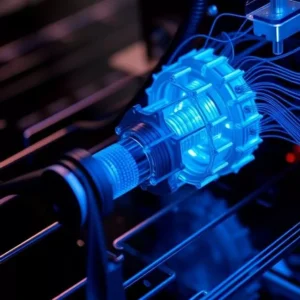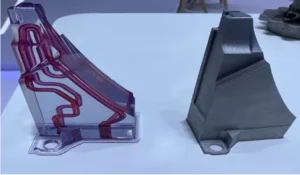Injection molding remains one of the most widely used manufacturing processes for producing complex plastic parts with precision and efficiency. Yet, despite decades of advancements, mold cooling remains a critical bottleneck affecting cycle times, product quality, and overall manufacturing costs. To overcome these challenges, manufacturers worldwide are adopting 3D printed conformal cooling channels—a transformative technology reshaping mold design and production.
In this article, we’ll explore why conformal cooling is gaining momentum, how 3D printing unlocks its potential, and what benefits manufacturers can expect when switching to this cutting-edge solution.
Understanding the Role of Cooling in Injection Molding
Injection molding involves melting plastic pellets, injecting molten plastic into a mold cavity, cooling the part until it solidifies, and then ejecting it. Among these steps, cooling often accounts for 60-80% of the entire cycle time. This makes cooling efficiency a prime target for process improvements.
Traditionally, cooling channels in molds are drilled straight and spaced evenly within the mold core and cavity. While straightforward to manufacture, these conventional channels cannot follow the complex contours of the mold, leading to uneven cooling. The consequences include:
- Longer cycle times as parts take more time to cool sufficiently.
- Warping and residual stresses caused by temperature gradients within the part.
- Inconsistent part quality and higher rejection rates.
To address these issues, conformal cooling channels—channels that conform to the shape of the mold cavity—have emerged as a superior alternative.
What Are 3D Printed Conformal Cooling Channels?
Conformal cooling channels are designed to follow the exact contours of the mold’s cavity and core, maintaining uniform distance from the surface of the molded part. This uniformity ensures consistent and efficient heat transfer during the cooling phase.
The challenge historically has been manufacturing these complex channels with traditional subtractive methods like drilling and milling. Complex curves and tight radii are difficult, costly, or impossible to produce conventionally.
Enter 3D printing (additive manufacturing)—a technology that builds molds layer by layer. With 3D printing, manufacturers can:
- Create highly intricate cooling channels with smooth curves that precisely match the mold geometry.
- Design optimized cooling networks that reduce hot spots and improve temperature uniformity.
- Integrate multiple cooling circuits within the same mold to further improve control.
These advantages enable conformal cooling to achieve what was previously unattainable.
Benefits of 3D Printed Conformal Cooling Channels
1. Significantly Reduced Cycle Times
By evenly removing heat from the molded part, conformal cooling drastically reduces cooling time. Cycle time reductions of 20-50% are common, directly translating to higher throughput and productivity.
Faster cycles mean you can produce more parts in less time, which improves overall equipment effectiveness (OEE) and shortens lead times.
2. Improved Part Quality and Consistency
Uneven cooling causes warping, sink marks, and internal stresses that degrade product quality. Conformal cooling channels maintain a consistent mold temperature, reducing defects and improving dimensional stability.
Parts produced with conformal cooling often require less post-processing or rework, reducing scrap and lowering production costs.
3. Extended Mold Life
Traditional cooling channels can cause thermal fatigue and uneven wear due to localized temperature spikes. With conformal cooling, temperature variations are minimized, extending mold longevity and reducing maintenance downtime.
4. Design Freedom
3D printing allows mold designers to innovate without manufacturing constraints. Cooling channels can snake through the mold exactly where needed, optimizing performance rather than compromising due to manufacturing limitations.
5. Energy Efficiency
Faster and more uniform cooling reduces the energy needed for mold temperature control. This results in lower utility costs and a smaller carbon footprint—a growing priority for sustainable manufacturing.
Applications Benefiting from 3D Printed Conformal Cooling
Conformal cooling is particularly advantageous for molds with complex geometries or thick sections where traditional cooling struggles. Industries seeing significant gains include:
- Automotive: Complex bumper covers, interior panels, and engine components benefit from consistent cooling to meet stringent quality standards.
- Medical Devices: Small, intricate parts require tight dimensional tolerances, which conformal cooling helps ensure.
- Consumer Electronics: Thin-walled housings and precision parts achieve better aesthetics and durability.
- Aerospace: Lightweight composite parts molded with advanced polymers see improved performance and reduced cycle times.
- Packaging: High-volume runs of containers and caps realize cost savings from shorter cycles.
Design Considerations for Effective Conformal Cooling
Implementing conformal cooling successfully requires careful design to maximize efficiency and mold durability. Key factors include:
- Channel Diameter and Distance: Cooling channels must be sized properly—too small restricts coolant flow and reduces heat transfer, while too large wastes space and weakens the mold. Typically, channels are placed 5–10 mm from the mold surface to ensure uniform cooling and prevent hot spots.
- Coolant Flow Rate and Circuit Layout: Adequate coolant flow is essential for consistent temperature control. Designers must balance channel size, pump capacity, and coolant properties. The layout—whether single or multiple loops—affects flow uniformity and pressure drop. Flow simulations help optimize these parameters.
- Material Selection: Mold and channel materials need to resist thermal cycling, mechanical stress, and corrosion. Alloys like maraging steel or tool steel powders are common choices due to their strength and stability, ensuring long mold life and consistent part quality.
- Integration with Mold Components: Cooling channels must be coordinated with ejector pins, slides, and inserts to avoid interference and maintain mold strength. Early collaboration between designers and engineers prevents assembly issues and optimizes performance.
- Thermal Simulation and Testing: Using simulation tools before production helps predict temperature distribution and improve channel design. Physical testing during initial runs validates and refines the cooling system.
By addressing these points, manufacturers can improve cycle times, part quality, and mold longevity.
Challenges and Future Outlook
Initial Investment and Lead Time
3D printed molds with conformal cooling often require higher upfront investment and longer initial lead times compared to traditional molds. However, the long-term cycle time savings, quality improvements, and reduced scrap typically justify this.
Skill and Software Requirements
Designing effective conformal cooling networks requires advanced CAD software and thermal simulation tools. Manufacturers need skilled engineers experienced in both additive manufacturing and injection molding.
Emerging Technologies
Advances in 3D printing, including multi-material printing and improved metal powders, will further enhance mold performance and reduce costs. Hybrid manufacturing—combining additive and subtractive processes—may offer the best of both worlds.
Conclusion
3D printed conformal cooling channels represent a paradigm shift in injection mold design and manufacturing. By enabling complex, highly efficient cooling networks that traditional methods can’t match, manufacturers gain:
- Faster cycle times
- Superior part quality
- Longer mold life
- Energy savings
- Greater design freedom
As competition intensifies and quality standards rise, adopting conformal cooling is becoming essential for injection molding shops aiming to stay ahead.
If you’re interested in exploring how 3D printed conformal cooling can transform your production process, or want to learn more about advanced mold manufacturing techniques, consider reaching out to experts like GT Proto. With years of experience in prototyping and additive manufacturing, they can guide you through the transition to more efficient, innovative mold solutions.
For more information or to discuss your specific project needs, visit www.gtproto.com and discover how modern technologies can boost your injection molding capabilities—without compromising quality or budget.


